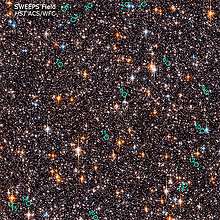XO Telescope
The XO Telescope is an astronomical telescope located on the 3,054 m (10,000 foot) summit of Haleakala on Maui, Hawaii. It consists of two 200-millimeter telephoto camera lenses, and resembles binoculars in shape. It is used by the XO Project to detect extrasolar planets using the transit method. It is similar to the TrES survey telescope. The construction of the one-of-a-kind telescope cost $60,000 for the hardware, and much more than that for the associated software.[1]
Planets discovered
The XO telescope has discovered six objects so far, five are hot Jupiter planets and one, XO-3b, is probably a brown dwarf. All were discovered using the transit method.
Light green rows indicate that the planet orbits one of the stars in a binary star system.
| Star | Constellation | Right ascension |
Declination | App. mag. |
Distance (ly) | Spectral type |
Planet | Mass (MJ) |
Radius (RJ) |
Orbital period (d) |
Semimajor axis (AU) |
Orbital eccentricity |
Inclination (°) |
Discovery year |
|---|---|---|---|---|---|---|---|---|---|---|---|---|---|---|
| XO-1[2] | Corona Borealis | 16h 02m 12s | +28° 10′ 11″ | 11.319 | 600 | G1V | XO-1b | 0.9 | 1.3 | 3.941534 | 0.0488 | 0 | 87.7 | 2006 |
| XO-2N[3] | Lynx | 07h 48m 07s | +50° 13′ 33″ | 11.25 | 486 | K0V | XO-2Nb | 0.57 | 0.973 | 2.615838 | 0.0369 | 0 | 88.58 | 2007 |
| XO-3[4] | Camelopardalis | 04h 21m 53s | +57° 49′ 01″ | 9.91 | 850 | F5V | XO-3b | 11.79 | 1.217 | 3.1915239 | 0.0454 | 0.26 | 84.2 | 2007 |
| XO-4[5] | Lynx | 07h 21m 33.1657s | +58° 16′ 05.005″ | 10.78 | 956 | F5V | XO-4b | 1.72 | 1.34 | 4.12502 | 0.0555 | 0.0024 | 88.7 | 2008 |
| XO-5[6] | Lynx | 07h 46m 51.959s | +39° 05′ 40.47″ | 12.1 | 881 | G8V | XO-5b | 1.15 | 1.15 | 4.187732 | 0.0508 | 0.0029 | 86.8 | 2008 |
| XO-6[7] |
F5V |
XO-6b | 2016 |
See also
- List of extrasolar planets
A subset of XO light curves are available at the NASA Exoplanet Archive.
Other Ground Transit Surveys
_at_Paranal.jpg)
- Next-Generation Transit Survey
- Trans-Atlantic Exoplanet Survey or TrES
- HATNet Project or HAT
- Kilodegree Extremely Little Telescope or KELT
- SuperWASP or WASP
References
- McCullough, P. R.; et al. (2005). "The XO Project: Searching for Transiting Extrasolar Planet Candidates". Publications of the Astronomical Society of the Pacific. 117 (834): 783–795. arXiv:astro-ph/0505560. Bibcode:2005PASP..117..783M. doi:10.1086/432024.
- McCullough, P. R.; et al. (2006). "A Transiting Planet of a Sun-like Star". The Astrophysical Journal. 648 (2): 1228–1238. arXiv:astro-ph/0605414. Bibcode:2006ApJ...648.1228M. doi:10.1086/505651.
- Burke, Christopher J.; et al. (2007). "XO-2b: Transiting Hot Jupiter in a Metal-rich Common Proper Motion Binary". The Astrophysical Journal. 671 (2): 2115–2128. arXiv:0705.0003. Bibcode:2007ApJ...671.2115B. doi:10.1086/523087.
- Johns-Krull, Christopher M.; et al. (2008). "XO-3b: A Massive Planet in an Eccentric Orbit Transiting an F5V Star". The Astrophysical Journal. 677 (1): 657–670. arXiv:0712.4283. Bibcode:2008ApJ...677..657J. doi:10.1086/528950.
- McCullough, P. R.; et al. (2008). "XO-4b: An Extrasolar Planet Transiting an F5V Star". arXiv:0805.2921 [astro-ph].
- Burke, Christopher J.; et al. (2008). "XO-5b: A Transiting Jupiter-sized Planet with a 4 day Period". The Astrophysical Journal. 686 (2): 1331–1340. arXiv:0805.2399. Bibcode:2008ApJ...686.1331B. doi:10.1086/591497.
- Crouzet, N.; et al. (2017). "Discovery of XO-6b: A Hot Jupiter Transiting a Fast Rotating F5 Star on an Oblique Orbit". The Astronomical Journal. 153 (3). 94. arXiv:1612.02776. Bibcode:2017AJ....153...94C. doi:10.3847/1538-3881/153/3/94.
- "New Exoplanet-hunting Telescopes on Paranal". www.eso.org. European Southern Observatory. Retrieved 14 January 2015.
External links
- The XO Project website
- Astronomers Catch Planet By Unusual Means (SpaceDaily) May 19, 2006

